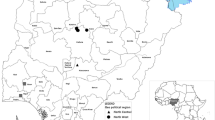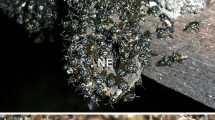Abstract
Uinalool was identified as the main component of the mandibular gland secretion in females and males of four species ofColletes bees, viz.,C. cunicularius, C. daviesanus, C. impunctatus andC. succinctus. It was also shown to be the dominant volatile compound in the same gland in maleC. floralis (the female of this species has not yet been investigated). Further, in another species,C. similis, linalool is present in the mandibular gland secretions of females and males, but the dominant volatile component in these secretions is geranial, together with neral. Females of the speciesC. fodiens seem to lack monoterpenes altogether; nonadecane is the dominant volatile compound of the cephalic secretion (based on analysis of a single individual). When linalool is put out in the area of nest aggregation ofC. cunicularius, where the males are “patrolling”, a distinct increase in flight activity is noted. The function of linalool is discussed on the basis of field observations.
Similar content being viewed by others
References
Alcock, J., Jones, C.E., andBuchmann, S.L. 1976. Location before emergence of the female bee,Centris pallida, by its male (Hymenoptera: Anthophoridae).J. Zool. (London) 179:189–199.
Batra, S.W.T. 1972. Some properties of the nest-building secretions ofNomia, Anthophora, Hylaeus and other bees.J. Runs. Entomol. Soc. 45:208–218.
Bergström, G. 1973. Use of a pre-column tube for the quantitative isolation of natural, volatile compounds for gas chromatography/mass spectrometry.Chem. Scr. 4:135–138.
Bergström, G. 1974. Macrocyclic lactones in the Dufour gland secretion of the solitary beesColletes cunicularius L. andHalictus calceatus Scop. (Hymenoptera, Apidae).Chem. Scr. 5:39–46.
Bergström, G., andTengö, J. 1974. Farnesyl and geranyl esters as main volatile constituents of the secretion from Dufour's gland in six species ofAndrena (Hymenoptera, Apidae).Chem. Scr. 5:28–38.
Butter, C.G. 1965. Sex attraction inAndrena flavipes Panz. (Hym., Apidae) with some observations on nest site restriction.Proc. R. Entomol.Soc. London (A). 40:77–80.
Enslin, E. 1922. Über Bienen und Wespen aus Nordbayern.Arch. Naturgesch. Abt. A. 88:233–248.
Guichard, K.M. 1974.Colletes halophila Verhoeff (Hym., Apidae) and itsEpeolus parasite at Swanscombe in Kent, with a key to the British species ofColletes Latreille.Entomol. Gaz. 25:195–199.
Hamamura, Y. 1965. On the feeding mechanism and artificial food of silkworm,Bombyx mori.Mem. Konan Univ. Sci. Ser. 8. (Art. 38). 17–22.
Hurd, P.D., Jr., andPowell, J.A. 1958. Observations on the nesting habits ofColletes Stepheni Timberlake.Pan-Pacif. Entomol. 34:147–153.
Jones, H.P. 1930. Mating habits ofAndrena argentata, etc.Entomol. Rec. J. of Var. 42:139.
Karrer, W. 1958. In Konstitution und Vorkommen der organischen Pflanzenstoffe. Birkhäuser Verlag, Basel, p. 56.
Kullenberg, B. 1956. Field experiments with chemical sexual attractants on Aculeate Hymenoptera males. I.Zool. Bidr. 31:253–352.
de Lello, E. 1971. Adnexal glands of the sting apparatus of bees: Anatomy and Histology. I. (Hymenoptera: Colletidae and Andrenidae).J. Kan. Entomol. Soc. 44:5–13.
Malyshev, S.I. 1927. Lebensgeschichte desColletes cunicularius L.Z. Morphol. Ökol. Tiere. 9:390–409.
May, G.O.K. 1974. An investigation of the chemical nature and origin of the waxy lining of the brood cells of a sweat bee,Augochlorapura (Hym., Halicitdae).J. Kans. Entomol. Soc. 47:504–516.
Noskiewicz, J. 1936. Die Palearktischen Colletes-arten.Pr. Nau. Wydawnictwo Towarzystwa Nandowego Lwowie, Ser. 2. 3:1–532.
Parliment, T.H., andScarpellino, R. 1977. Organoleptic techniques in Chromatographic food flavor analysis.J. Agric. Food. Chem. 25:97–99.
Prelog, V., andWatanabe, E. 1957. Über die absolute Konfiguration von Linalool und über den sterischen Verlauf der Umwandlung von Linalool in α-Terpineol.Liebigs Ann. Chem. 603:1–8.
Rau, P. 1920–1923. Ecological and behavior notes on Missouri insects.Trans. Acad. Sci. St. Louis. 24:1–71.
Rau, P., andRau, N. 1916. Notes on the behavior of certain solitary bees.J. Anim. Behav. 367–370.
Richards, O.W. 1937. A study of the British species ofEpeolus Latr. and their races, with a key to the species ofColletes (Hym., Apidae).Trans. Soc. Br. Entomol. 4:89–130.
Scheloske, H.W. 1974. Untersuchungen über das Vorkommen, die Biologie und den Nestbau der SeidenbieneColletes daviesanus Sm.Zool. Jb. Syst. 101:153–172.
Stephen, W.P. 1954. A revision of the bee genusColletes in America north of Mexico (Hym., Colletidae).Univ. Kans. Sci. Bull. 36:149–509.
Ställberg-Stenhagen, S. 1972. Splitter-free all glass intake system for glass capillary gas chromatography of volatile compounds from biological material.Chem. Scr. 2:97–100.
Sundermann, H. 1975. Europäische und mediterrane Orchideen. Eine Bestimmungsflora mit Berücksichtigung der ökologi. 2 Auflage. Hildesheim.
Tengö, J., andBergström, G. 1976. Comparative analyses of lemon-smelling secretions from heads ofAndrena F. (Hym., Apoidea) bees.J. Comp. Biochem. Physiol. 55B:179–188.
Tengö, J., andBergström, G. 1977. Comparative analyses of complex secretions from heads ofAndrena bees (Hym., Apoidea).J. Comp. Biochem. Physiol. 57B:197–202.
Young, J.C., Brownlee, R.G., Rodin, J.O., Hildebrand, D.N., Silverstein, R.M., Wood, D.L., Birch, M.C., andBrowne, L.E. 1973. Identification of linalool produced by two species of bark beetles of the genusIps.J. Insect Physiol. 19:1615–1622.
Author information
Authors and Affiliations
Additional information
This report forms part XXI in the series “Studies on Natural Odoriferous Compounds.”
Rights and permissions
About this article
Cite this article
Bergström, G., Tengö, J. Linalool in mandibular gland secretion ofColletes bees (Hymenoptera: Apoidea). J Chem Ecol 4, 437–449 (1978). https://doi.org/10.1007/BF00989500
Received:
Revised:
Issue Date:
DOI: https://doi.org/10.1007/BF00989500




